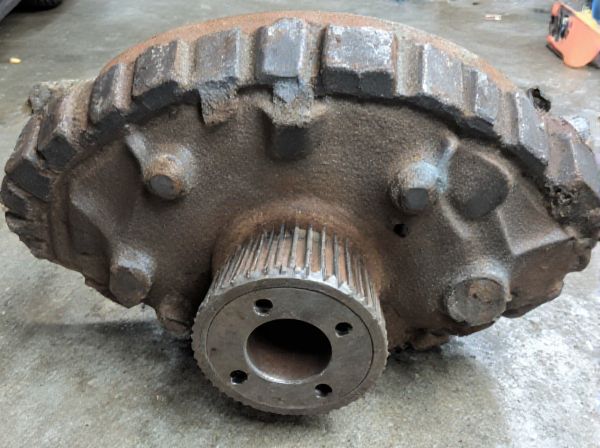
Photo illustration: Clutch-type Limited Slip Differential vs Helical-gear Limited Slip Differential
Clutch-type limited slip differentials use friction plates to transfer torque between wheels, providing strong and immediate traction during wheel slip conditions. Helical-gear limited slip differentials rely on sets of helical gears that automatically distribute torque smoothly without the need for friction materials or maintenance. Choosing the right differential affects Your vehicle's handling and performance, with clutch types offering more aggressive traction and helical-gear types delivering quieter, more durable operation.
Table of Comparison
| Feature | Clutch-type Limited Slip Differential | Helical-gear Limited Slip Differential |
|---|---|---|
| Mechanism | Friction clutch packs engage to limit slip | Helical gears distribute torque between wheels |
| Torque Bias Ratio | High, adjustable via clutch preload | Moderate, fixed by gear design |
| Maintenance | Requires periodic clutch replacement | Low maintenance due to gear-based design |
| Smoothness | Can cause chattering under low speeds | Smoother operation, no chatter |
| Durability | Clutch wear reduces lifespan | High durability with minimal wear |
| Cost | Generally less expensive | Typically higher cost |
| Applications | Performance vehicles, motorsports | All-wheel drive and street cars |
Introduction to Limited Slip Differentials
Limited Slip Differentials (LSDs) improve traction by distributing torque between wheels, preventing slip during acceleration or cornering. Clutch-type LSDs use friction plates to transfer torque, offering adjustable locking and responsiveness ideal for high-performance applications. Helical-gear LSDs rely on worm and spur gears to automatically manage torque split without wear-prone components, providing smooth operation and durability in everyday driving conditions.
Understanding Clutch-Type LSD: Basics and Mechanism
Clutch-type limited slip differentials (LSD) use friction plates to transfer torque between the wheels, providing improved traction by limiting wheel slip during acceleration or cornering. The mechanism involves multiple clutch discs housed within the differential, which engage when a difference in wheel speed is detected, effectively distributing power to the wheel with more grip. This design offers precise control and is commonly used in performance vehicles for enhanced handling and stability.
Helical-Gear LSD Explained: Design and Function
Helical-gear limited slip differentials use a set of angled helical gears to distribute torque between the wheels, enabling smooth power transfer without the abrupt lock-up characteristic of clutch-type LSDs. This design allows the differential to automatically modulate torque based on wheel slip, improving traction and handling in various driving conditions. The absence of clutch plates reduces maintenance and wear, making helical-gear LSDs more durable and reliable in both high-performance and everyday vehicles.
Performance Comparison: Clutch vs Helical-Gear LSD
Clutch-type limited slip differentials (LSDs) offer faster response and adjustable locking force, providing superior traction under high-torque conditions, making them ideal for aggressive driving and motorsports. Helical-gear LSDs deliver smooth, maintenance-free operation with progressive torque transfer, enhancing stability during cornering and reducing wheel hop in everyday driving. Performance-wise, clutch LSDs excel in immediate grip and tunability, while helical-gear LSDs prioritize durability and consistent traction without driver intervention.
Traction and Handling Differences
Clutch-type limited slip differentials provide strong, immediate traction by using friction plates to transfer torque, making them highly effective in low-traction conditions and aggressive driving scenarios. Helical-gear limited slip differentials deliver smoother, more consistent torque distribution through gear action without friction plates, enhancing stability and predictable handling during cornering. While clutch-type LSDs offer sharper response and better lock-up under slip, helical-gear LSDs excel in maintaining steady traction with less maintenance and quieter operation.
Durability and Maintenance Considerations
Clutch-type limited slip differentials (LSDs) typically require more frequent maintenance due to clutch wear and the need for periodic fluid changes to prevent overheating and maintain optimal performance. Helical-gear LSDs, with their all-gear design and absence of clutch plates, offer superior durability and lower maintenance demands, making them more suitable for extended use in harsh conditions. The inherent mechanical robustness of helical-gear LSDs reduces the likelihood of costly repairs and extends service intervals compared to the clutch-type variants.
Cost Analysis: Clutch-Type vs Helical-Gear LSD
Clutch-type limited slip differentials (LSDs) generally incur lower manufacturing and repair costs due to simpler mechanical components and easier access for maintenance. Helical-gear LSDs demand higher initial investment due to precision-machined gears and more complex assembly processes, translating to increased production expenses. Long-term cost-efficiency favors clutch-type LSDs in budget-sensitive applications, whereas helical-gear LSDs offer enhanced durability and smoother torque distribution that can reduce maintenance frequency despite higher upfront costs.
Suitable Applications for Each LSD Type
Clutch-type limited slip differentials excel in high-performance sports cars and off-road vehicles where aggressive torque transfer and wheel grip under variable conditions are critical. Helical-gear limited slip differentials are ideal for everyday passenger cars and light trucks, providing smooth torque distribution with minimal maintenance and improved traction on slippery surfaces. Each LSD type suits distinct driving environments, with clutch-type favoring dynamic, high-torque scenarios and helical-gear optimal for consistent, all-weather stability.
Pros and Cons: Clutch-Type LSD
Clutch-type limited slip differentials provide strong and predictable torque transfer, offering superior traction in extreme driving conditions and allowing for effective power distribution during wheel slip. However, they require periodic maintenance, such as clutch pack replacement, and can produce noticeable chatter or noise under certain driving situations. The mechanical complexity and increased wear may also lead to reduced durability compared to helical-gear LSDs.
Pros and Cons: Helical-Gear LSD
Helical-gear limited slip differentials provide smooth torque transfer with minimal maintenance due to their gear-based design and no friction plates. They excel in durability and quiet operation, making them ideal for street and all-wheel-drive applications. However, they may struggle with torque biasing under extreme conditions compared to clutch-type LSDs, which offer more precise control but require regular servicing.
 caratoz.com
caratoz.com